ABBEYS AND MONASTERIES
Introduction
According to recent studies, the Middle Ages, a period spanning between the 5th and 15th century, were not as obscure as they have been depicted. However, it was a time of widespread violence, poverty and ignorance. In this context, monasteries and abbeys literally saved western culture. Monasteries were self-sufficient, autonomous structures that often became rich and influential. Incidentally, it should be kept in mind that only seldom did monks attend to menial or manual tasks, which were the prerogative of peasants or lay servants: the motto Ora et Labora should be read as an exhortation to praise God through prayer and study of holy texts. Their indefatigable work led to the collection and reproduction of books whose subjects were religious as well as cultural at large, and thus to the preservation of classic Latin and Greek works.
Besides, by founding the construction of abbeys and monasteries many local lords sought political consensus and atonement. In other cases, monasteries were founded by the Longobards to consolidate their territorial dominion –such was the case, for example, with Santa Giustina at Sezzadio.
This highly secularised monasticism was paralleled by a more ascetic conception of religious life which led to the establishment of isolated cells and of structures devoted to assisting the sick and poor, as did the Antonian fathers at Ranverso.
General decline began in the 15th century, brought about, among other things, by secularization and excessive expansion. Monasteries were deserted and their estates and possessions sold, stolen or vandalised, while buildings were variously redeployed as military quarters, stables, warehouses or even hotels.
Restorations began in the 19th century, when the Middle Ages became fashionable again. Today, most of Piedmont’s ancient abbeys have been brought back to life; they can be visited and in several cases monastic life has also been resumed.
Sacra di San Michele
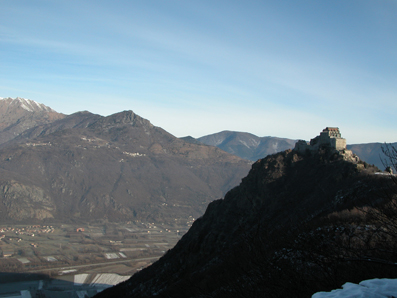 The Benedictine abbey of San Michele della Chiusa is a breathtaking complex built on and around the top of Monte Pirchiriano. Its construction began between 983-987.
The Benedictine abbey of San Michele della Chiusa is a breathtaking complex built on and around the top of Monte Pirchiriano. Its construction began between 983-987.
This monument is more commonly known as Sacra di San Michele -St. Michael’s Holy. Holy, like the mountain on which it was build; holy, like the noble abbey; holy because, being "planted" on a rock overhanging the surrounding plain, it is an architectural miracle in its own right. Since its foundation, the Sacra worked for the European cultural and social élite. Its splendour, which lasted till the late 14th century, was superseded by irreversible decline: the last three monks left the Abbey in 1622. The complex was then looted, bombarded (in 1693), badly damaged by earthquakes and had its abbatial title suppressed in 1803. In the 1830's, the Savoy king Carlo Alberto commissioned the restoration of the abbey and relaunched it as a religious centre.
The Sacra was built between the 12th and 13th centuries; its structure is therefore Romanesque and Gothic. However, building and rebuilding continued for over ten centuries, and the fascination of this huge stone structure lies precisely in the amazing architectural solutions adopted in order to overcome the ruggedness of the terrain.
The first construction (now dilapidated) along the path is the so-called Sepolcro dei Monaci (the Monks' Sepulchre): actually, it was not a burial ground but rather the place where the Holy Host was kept. Just beyond this building a steep path leads to the Porta Ferrata (the Iron Gate, a squat tower with a single opening delimitating the compound rising on and around the top of the mountain). The southern side is occupied by two constructions: the Foresteria (guest quarters) and the Monastero Vecchio (Old Monastery), built in the 11th century and soon enlarged with the construction of the Monastero Nuovo (New Monastery, now collapsed), originally surrounded by a wall. Construction continued through the 12th century.
The lack of natural space was obviated by the creation of man-made space, consisting of a huge platform where other buildings could be erected, and older structures encased. The structure includes the awesome Scalone dei Morti (the Staircase of the Dead), a steep staicase whose walls had niches long used as open tombs for the monks.
In the rich Mediaeval symbolism, climbing these macabre steps mirrored the soul’s elevation from darkness to the light flooding the Portale dello Zodiaco (the Zodiac Gate) sculpted by Nicholaus, one of the greatest artists of the 12th century.
The Romanesque-Gothic abbey church is simple and solemn. A small, steep staircase at the centre of the main nave leads down to three ancient chapels built by the hermits who inhabited the mountain between the 6th-10th centuries.
Regional authorities, acknowledging the cultural and artistic relevance of the complex, have chosen the Sacra as the symbol of Piedmont.
Novalesa
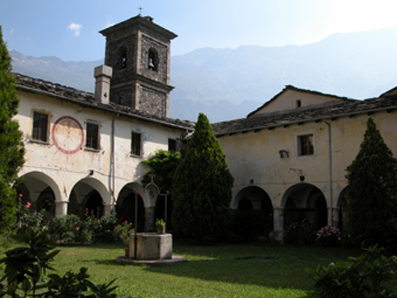 It was founded in 726 A.D. to satisfy religious as well as strategic needs, as it was an outpost marking the Frankish control over territories surrounding the Mont-Cénis pass.
It was founded in 726 A.D. to satisfy religious as well as strategic needs, as it was an outpost marking the Frankish control over territories surrounding the Mont-Cénis pass.
The general outlay of buildings has not changed since the 12th century, yet this abbey had undergone –and survived- many traumatic events. In 906, pending the threat of a “Saracen” invasion, all resident monks fled to Turin, where they stayed till the end of the century. The abbey flourished till the late 14th century, then decadence began, culminating in the 19th century when the complex became a spa resort. Restorations began in the 1970’s, leading to resumption of monastic life.
Ever since its foundation, the abbey was articulated in two main structures: one is centred upon the abbey church (completely rebuilt between 1712-1715) and the cloisters. The other is composed of four chapels, only two of which preserve their original structure. Inside, three of the chapels (Santa Maria, San Michele, and S. Salvatore) have had their 9th-century frescoes destroyed and partially repainted in Baroque style. The fourth chapel, dedicated to St. Eldred, still possesses its Romanesque frescoes, dominated by a Byzantine-style figure of Christ Enthroned.
Sant'Antonio di Ranverso
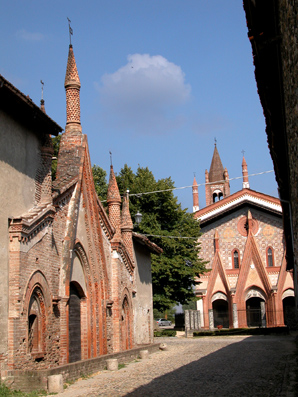 Founded in 1188 along the ancient route to France, it is one of the most remarkable examples of late-Medieval architecture in Piedmont. And just as important are its frescoes.
Founded in 1188 along the ancient route to France, it is one of the most remarkable examples of late-Medieval architecture in Piedmont. And just as important are its frescoes.
St. Anthony was worshipped as protector of domestic animals and as the inventor of a cure for Herpes Zoster (aka St. Anthony’s Fire), a painful and widespread disease. The cure consisted in placing pork’s fat or lard over the sores caused by the disease, thus avoiding contact with air and easing the pain.
The gothic façade of the abbey church, with its three tall posts, was built in the late 15th century, whereas the bell-tower was erected in the 1300’s replacing an older one.
Inside the church, frescoes and decorations have been badly damaged by time and by several modifications, but remain some of the most interesting in Piedmont. The apse is dominated by a polyptich by Defendente Ferrari and by 14th-century frescoes. In 1914, during reparation works, frescoes by Jacquerio were discovered in the choir area.
Staffarda
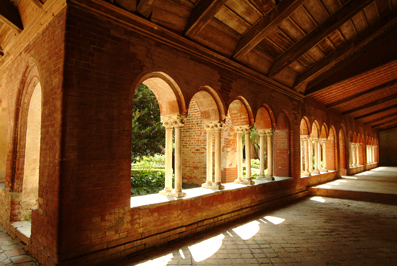 The Cistercian abbey of Staffarda was the richest in Piedmont, and is also the best preserved. A small stele commemorates the settlement of the area by the monks in 1135. The abbey’s buildings were erected in the 12th century, replacing older wooden structures. The simple, enchanting church was built first, then all other buildings.
The Cistercian abbey of Staffarda was the richest in Piedmont, and is also the best preserved. A small stele commemorates the settlement of the area by the monks in 1135. The abbey’s buildings were erected in the 12th century, replacing older wooden structures. The simple, enchanting church was built first, then all other buildings.
The cloisters, built around 1250, are probably the most elegant in Piedmont, and so is the chapter house.
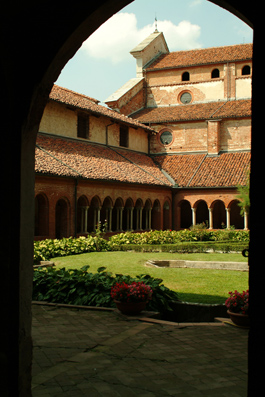 Separated from the abbey’s main body are the Loggia del Grano, an open gallery once used as market place, and the guest quarters. The entire defensive system has disappeared, with the exception of the original fortified gate, now incorporated into a wall.
Separated from the abbey’s main body are the Loggia del Grano, an open gallery once used as market place, and the guest quarters. The entire defensive system has disappeared, with the exception of the original fortified gate, now incorporated into a wall.
The complex is completed by the 14th-century bell-tower.
Vezzolano
Legend has it that the abbey was founded by Charlemagne, but the act of foundation is dated 1095. All that is left of the original complex are the abbey church and cloisters.
Seen from the outside, the church seems to have three naves, but it actually has two, as the third was probably never built or demolished. A small door at the bottom of the right-hand wall leads to the small cloisters: the western side is the oldest, and was built in the 12th century. The north side, built later, may have replaced the third nave.
Santa Giustina, Sezzadio
All that remains of this once-important abbey is the church. The abbey may have been founded by the Longobard king Liutprando. Sharing the fate of all other abbeys, Santa Giustina began declining the late 14th century, and all attempts to revive religious life were unsuccessful. After Napoleon’s suppression of monasteries, this one was allotted to the veterans and turned into a warehouse. Restorations, wherever possible, were started in 1956.
The church offers one of the most remarkable examples of pre-Romanesque architecture in Piedmont. Inside, the 19th-century devastation could not be repaired, but the crypt, the oldest part of the church, has remained intact and preserves a spectacular mosaic floor.
Sant'Andrea, Vercelli
This abbey was built between 1219-1227 within an urban environment, and seems to anticipate a new conception of towns as religious and cultural centres. Thus, St. Andrea is ideally connected to the cathedrals of central and northern Europe. However, its architect –most likely, the great Benedetto Antelami- did not sever connections with local tradition, but resumed the older, Northern Italian Romanesque schemes, with extraordinary results. The façade is a marvellous fusion of Gothic and Romanesque styles, whereas the inside if fully Gothic, harmonious and solemn. A door at the bottom of the transept leads to the cloisters, substantially modified during the centuries.
Orta San Giulio
The abbey was built between the 10th and 12th centuries on the small island in the middle of Lake Orta. The façade was rebuilt in the 1600’s, but its Romanesque outline is still visible. Inside, frescoes and decorations span several centuries, but the main feature is the black marble pulpit, dating from the early 12th century, which is the foremost masterpiece of Romanesque sculpture in Piedmont.
Two staircases siding the presbytery lead to the crypt, built between 1697-98 to house the remains of five saints including Giulio.
OTHER STRUCTURES
Province of Turin
Santa Maria, Cavour
It was built in 1037 replacing older structures, and later modified. Its three-nave crypt preserves columns with Longobard and even Roman capitals.
Fruttuaria, San Benigno Canavese
All that is left of the original structure, demolished and rebuilt in the 18th century, is the 10th-century bell-tower and parts of the abbey church underneath the present-day church floor.
Santa Fede, Cavagnolo
Founded in the 12th century, it has one of the most richly decorated portals in Northern Italy
Province of Alessandria
Santa Maria di Rivalta Scrivia, Tortona
It was founded in the late 12th century on an older site and built according to the canons of Cistercian Gothic. Inside, the church has frescoes dating from the late 1400’s. The decline of the abbey appeared irreversible as early as 1457. All that is left of the original buildings is the chapter house, very similar to Staffarda’s.
Province of Cuneo
Villar San Costanzo
This abbey was founded in the 8th century AD, but the earliest constructions were destroyed when the complex was rebuilt around the year 1000. The Romanesque-Gothic belfry was erected in the late 13th century. The church of San Costanzo al Monte also belonged to the abbey.
Province of Novara
Santi Nazario e Celso, San Nazzaro Sesia
Founded in the mid-10th century, it replaced an earlier complex and controlled an important ford on the road to France. Extensive rebuilding was carried out in the 1400’s, and all that remains of the original structure are the imposing bell-tower and the strange narthex with two porticoed wings.
The façade of the church -a sober, solemn building dedicated in 1450- is finely decorated with tiles. The cloisters were entirely frescoed, but most of the decoration has been lost.
Province of Vercelli
Santa Maria di Lucedio, Trino
The present-day name refers to the more recent of two monastic settlements. The older was the Benedictine abbey of San Genuario, probably dating back to the 6th century. This abbey enlarged its estates and power impressively between the late 9th and the first half of the 12th century, then decline began. It was abolished in 1855, and all that is left of this grand complex is the shell of the main apse.
The other monastery is Cistercian, and was founded in the 12th century. Cistercian monks are also credited with introducing rice cultivation in the area. This abbey shared the fate of others, and decline appeared irreversible by the late 1300’s. In the 19th century, the core of its estates became the Princedom of Lucedio.
All that is left of the original abbey church are the 12th-century bell-tower and part of the chapter house, whereas the rest of the church has been rebuilt in late-Baroque style in the 1700’s.
